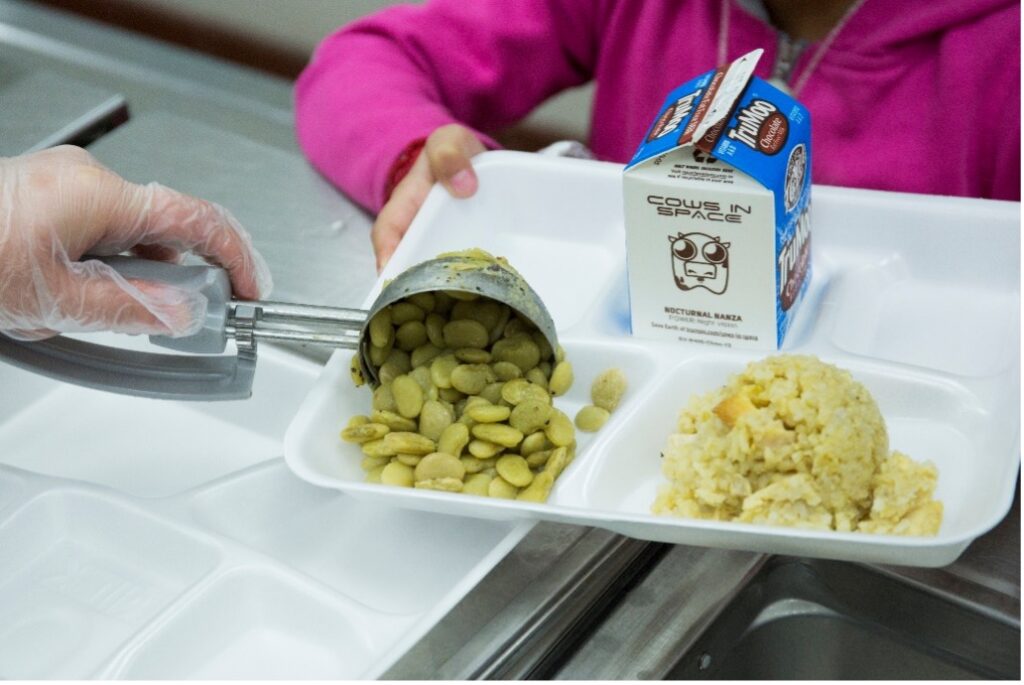This weblog is a part of a sequence known as Fish-nomics , analyzing essential subjects regarding seafood business issues from an economist’s perspective.
Picture courtesy of Tyler Jones, UF/IFAS.
In 2022 the US Authorities Accountability Workplace (GAO) issued a report on seafood at school lunch applications. The report discovered that between 2014 and 2019, the USDA’s Nationwide Faculty Lunch Program’s (NSLP) seafood purchases solely accounted for 1.5% of whole animal protein bought by this system. On common, the NSLP supplied U.S. college students with solely 3 ounces of seafood per 12 months whereas the USDA’s personal Dietary Tips for Individuals suggest school-age kids eat 4-10 ounces of seafood per week relying on age.
Bettering entry to seafood for youngsters by the NSLP represents a possibility to enhance scholar well being and improve demand for U.S. produced seafood. Growing the proportion of NSLP purchases of animal protein from seafood to fifteen% would require the USDA to purchase 55.7 million extra kilos of U.S. produced seafood per 12 months.
The necessity for extra seafood at school lunches is highlighted by the truth that USDA knowledge indicated that the majority U.S. school-age kids don’t eat the advisable quantities prescribed by the Dietary Tips for Individuals. Seafood is a vital supply of key vitamins, minerals, and nutritional vitamins together with omega-3 fatty acids, nutritional vitamins B12 and D, selenium, zinc, and iodine. Research concerning these vitamins, minerals, and nutritional vitamins have proven advantages together with decreased threat of heart problems, sure cancers, cognitive decline (together with Alzheimer’s illness and dementia), and melancholy, whereas probably bettering immune perform, bone well being, eye well being, and fetal and toddler growth.
The USDA’s Strategic Plan signifies that one of many Company’s targets is to assist and encourage wholesome consuming by working with faculties to enhance entry to nutritious meals choices, like seafood. Nevertheless, to do that the USDA might want to alert consumers for NSLP of the supply of latest seafood merchandise. The GAO report concerned interviews with 20 of those directors as to why they didn’t try to incorporate extra seafood at school lunches by the NSLP. The three mostly cited considerations included: worries about seafood security, scholar preferences for different animal proteins, and availability of seafood.
Instructional applications for directors, dad and mom, and college students might lower considerations about seafood security and alter preferences for seafood, whereas academic applications particularly for directors might improve the number of seafood provided by the NSLP. Between 2014 and 2019, the one seafood merchandise provided by this system have been Alaska pollock, canned tuna, and catfish bought from a complete of 11 distributors. Whereas these are good seafood decisions, a greater variety of choices together with shrimp and salmon, the 2 most consumed forms of seafood within the U.S., might lower worries about scholar preferences for different animal proteins and improve seafood uptake within the NSLP.
Picture courtesy of Tyler Jones.
Together with shrimp within the NSLP would improve seafood in scholar diets and bolster one in all America’s largest fisheries. Shrimp is by far essentially the most consumed seafood sort within the U.S. and accounts for 29% of whole U.S. seafood consumption, and school-age kids are more likely to be aware of and keen to eat shrimp by the NSLP. Introducing shrimp into the NSLP might enhance the willingness of directors to strive including different seafood choices to highschool lunches and make kids extra keen to strive different forms of seafood each in school and at dwelling.
Moreover, together with U.S. wild-caught shrimp within the NSLP would offer one other potential marketplace for the fishery. The U.S. shrimp fishery is among the 5 largest business fisheries within the U.S.; nonetheless, cheaper imported shrimp has negatively impacted the fishery and the coastal communities that depend on the fishery. If the proportion of NSLP animal protein supply purchases from seafood elevated from 1.5% to fifteen%, and simply half of the elevated purchases have been U.S. wild-caught shrimp, the USDA would purchase 27.9 million extra kilos – or 10% of all shrimp landed within the U.S. in 2020. This kind of change to the NSLP would improve scholar consumption of nutritious high-quality seafood as advisable by the USDA Dietary Tips for Individuals and profit U.S. fishermen and coastal communities.
If you want to voice your considerations in regards to the lack of wholesome seafood choices within the NSLP or different points vital to you, you need to use this hyperlink to seek out your elected officers and call them to precise your opinions.
For extra info or questions on seafood at school lunch applications, please contact Andrew Ropicki at aropicki@ufl.edu.
